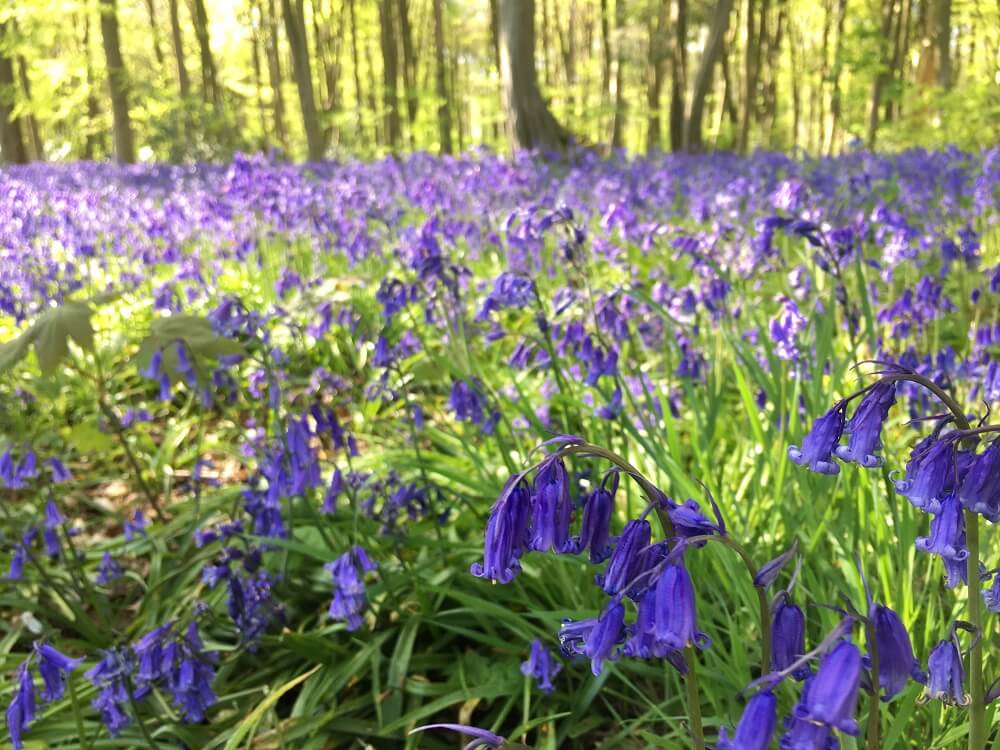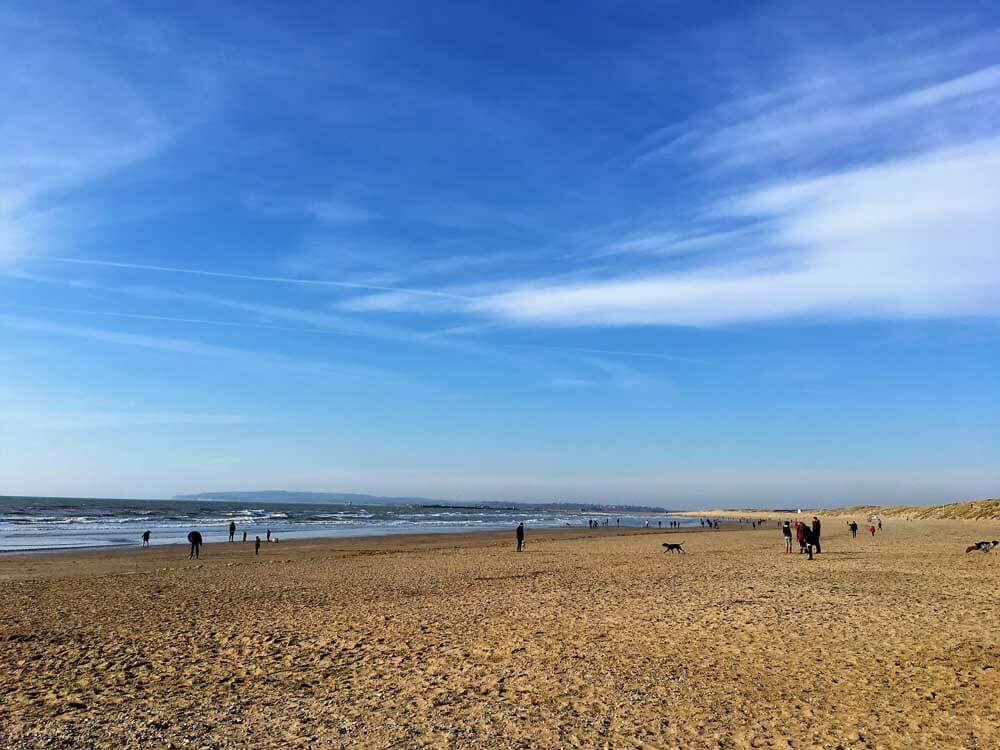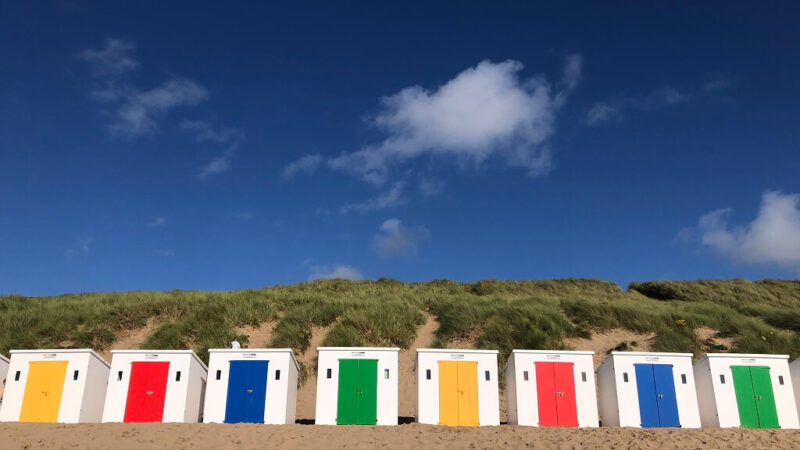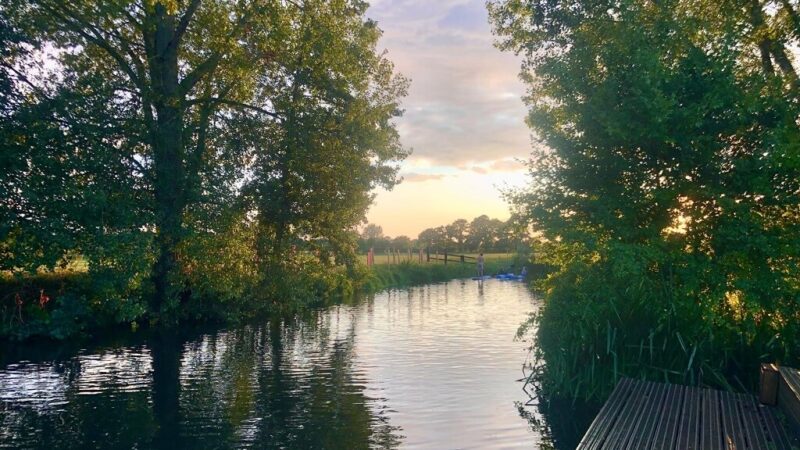Beautiful bluebell woods to enjoy this spring

Looking forward to seeing bluebells in the woods this spring? Knowing that this glorious time of year is just around the corner always gets me through those cold dark days of winter. I’m lucky to have plenty of bluebell woods near me – some well known, and a few hidden gems which only us locals know about!
So, if you’re after a wildflower fix, read on for my recommendations of the best bluebell walks to enjoy this spring.
Table of Contents
When do bluebells come out?
Peak bluebell season varies from year to year and from location to location. If you want to guarantee a really good display of bluebells in England, head out into the woods towards the end of April or at the start of May. Sometimes they bloom in early April and other years they still look good until mid May.
Obviously, the further north you travel in the UK, the later the plants are likely to flower – bluebells in woods in Scotland and Northern Ireland will likely be a week or two behind those in England and Wales.
Some bluebell facts
Bluebells are protected! As tempting as it might be, digging up bluebells is prohibited and landowners cannot remove bluebells from their land to sell. The seeds from these dainty flowers take around five years to develop into the bulbs from which the new plants grow.
Although you might fancy striding through a bluebell wood or doing a photoshoot with your dog or child, it’s important to stay to the path and avoid stepping on these gentle blooms. They are easily damaged and once trampled on, they can struggle to return the following year. So don’t follow the usual mantra of “leave only footprints” – when it comes to bluebells, it’s best if you leave nothing at all.
How to identify the common bluebell
Our native bluebell – the common bluebell – is the one we need to protect. It can be easily confused with the Spanish bluebell, an invader dating back to the 17th century which threatens our little native flower.

The difference between the two is pretty straight forward: the common bluebell has flowers on one side of its stem which causes it to droop slightly whereas the Spanish bluebell has flowers on both sides of the stem and is more upright. The Spanish bluebell is more likely to be found in gardens than growing wild in our woodlands.
Other spring flowers to look out for
If you can’t wait for the bluebells but fancy checking out some of our other stunning wild flowers, keep a look out for the beautiful white stitchwort which often carpets woodlands a few weeks before the bluebells. I also love the wood anemone, another white bloom which you’ll find in springtime.
Bluebell walks in London
London is blessed with some fantastic green spaces so if you’re after a bluebell fix you don’t have to leave the capital.
In north London, Highgate Wood is a good choice for those who don’t want to venture too far out of the city centre. A short walk from Highgate tube station, the wood is crisscrossed by a network of paths and there’s a little play area for youngsters.

For something more expansive, and the opportunity to get close to wildlife as well as wild flowers, Richmond Park is a lovely choice for a day out. The best spot for bluebells in Richmond Park is the Isabella Plantation which is also well known for its colourful azaleas. These evergreen shrubs bloom at a similar time of year to the bluebells. You can find out more in the Royal Parks monthly plant diaries which highlights plants to look out for each month.
If you’re visiting Richmond Park by public transport, it’s quite a walk from Richmond station so check bus links or hire a bike.
Wanstead Park as a less well known spot for seeking out London bluebells, lying east of Stratford. Once the grounds of a stately home, elements of its aristocratic past remain including ornamental lakes and a folly (now museum). The Wanstead woods bluebells can be found just east of the Temple in Chalet Woods. It’s around 20 minutes walk from Wanstead tube station to Chalet Woods.
Quite a few of the bluebell woodlands I’ve written about in Hertfordshire are easily accessible from London by train – take a look below or read my article about where to find bluebells in Hertfordshire if you fancy a day out of the capital.
Bluebell woods in Hertfordshire
I live in Hertfordshire and I’m really spoilt for choice when it comes to bluebell walks near me. Every little woodland pocket has a carpet of flowers in the springtime – it’s a magical time to live in this part of the world. I’ve listed a few of the best Hertfordshire bluebell woods here but for more options – including my favourite bluebell walk – take a look at my article on bluebell walks in Hertfordshire.
Ashridge Estate, near Berkhamsted

What3words car park location: ///factoring.envisage.query
This is the most well know place to see bluebells in Hertfordshire. The estate – managed by the National Trust – is vast with open parkland, fields and woods to explore. There are bluebells in various parts of the Ashridge Estate but the most popular spot is Dockey Wood which is around a mile from the main visitor centre and has its own car park.
On our visit to the Ashridge Estate, we parked at the visitor centre and enjoyed several walks from there. The bluebell woodlands were stunning and we had the benefit of proximity to the café and play area.
Ashridge Estate is a great day out (at any time of year) with walks of all lengths and abilities. As well as walking trails, there are also dedicated cycle paths including a four mile route for families.
Find out more about the Ashridge Estate here
Heartwood Forest, near St Albans

What3words car park location: ///supply.farm.stores
This woodland close to the village of Sandridge and just north of St Albans is a great success story. Although parts of Heartwood are ancient woodland, much of it is newly planted – done so by hundreds of local volunteers.
Read about our trip to Heartwood here.
Visitors to Heartwood can walk, cycle or horse ride along various paths and tracks, following specifically designated routes – short ones for little legs such as the Magical Meander and longer trails for those who fancy more of a challenge.
The bluebells are found in Langley Woods which is around 10 minutes walk from the car park. The Woodland Trust has roped off the bluebells to ensure they are not trampled on. It’s a really stunning display, particularly on a sunny day when the light streams into the bluebell forest.
Find out more about Heartwood Forest here.
For more family friendly walks in Hertfordshire – including the brilliant Broxbourne Woods Sculpture Trail – take a look at my article about Hertfordshire walks.
And if you need a few tips to help get your kids out walking, check out my article about hiking with children.
Bluebell woods in Bedfordshire
RSPB The Lodge, Sandy
What3words car park location: ///defenders.growl.measures
This RSPB nature reserve is a great destination all year round for nature lovers. There’s a visitor centre, nature trails, and a children’s play area. However, if you visit in the spring, the Lodge has an added attraction – carpets of bluebells to enjoy.
There are also two ancient hill forts at the Lodge, visitors can wander the ditches and banks – great for little children as well as more mature history buffs!
Find out more about the Lodge Sandy
Chicksands wood
What3words car park location: ///icons.titles.perkily
If you’re a cyclist, you might know of Chicksands because of its hair-raising bike park. But it’s also a great place for a bluebell walk in Bedfordshire. The local parish council have put together a useful walking guide for the woods and have pinpointed on a map where the best display of blooms is.
Find out more about Chicksands wood
Bluebell woods in Buckinghamshire
Penn wood, near Amersham

Recommended by Kristin from Scotland Less Explored
What3words car park location: ///tape.begins.quench
Penn Wood is close to Amersham and High Wycombe. Parking is available next to Holy Trinity Church on Penn Street and it is possible to get the tube or train from London to Amersham. From Amersham Station it is a one hour walk or a short taxi ride to the woods.
If you’re planning to explore the Penn Wood bluebells with a buggy, the main paths are well surfaced. If you don’t have a buggy there are several longer walks in the area such as the 6.5 kilometre circular walk which also takes you through Common Woods. Allow around one and half to two hours for this walk.
For a full day excursion the 16 kilometre walk between Great Missenden and Amersham takes around five hours. The landscape is varied ranging from woods to open fields and charming villages such as Little Missenden. In Great Missenden visit the Roald Dahl Museum and in Amersham don’t miss seeing the picturesque old town.
Close to Penn Woods Village Hall there are two pubs – the Squirrel and The Hit & Miss. Both are good options for lunch but make sure you book in advance on weekends.
Find out more about Penn Wood here
Bluebell woods in Somerset
Long Wood, Cheddar Gorge, Somerset

Recommended by Suzanne from Meandering Wild
What3words car park location: ///moguls.radio.fatherly
The walk to the bluebell woods at Cheddar Gorge takes you from a small parking area at the top of the gorge through the old quarry at Black Rock. Here you can see the old lime kilns and explore the large rocks that remain. This part of the walk is suitable for buggies and it isn’t until you go through the gate into Long Wood that it becomes a bit too rough.
Long Wood has a circular walk that first of all goes up a series of steps through the bluebell wood to the top of the deep sided valley. The path circles around before dropping down to the valley floor. Here there is a small stream, old mine workings and cave entrances that are safely railed off. The complete walk is around five kilometres and takes approximately one hour.
If you are feeling energetic you can walk from Cheddar Gorge following the top of the cliffs all the way to Long Wood before returning on the opposite side of the gorge. This circular walk is very steep in places covering seven kilometres and taking around two hours.
After your walk you can explore Cheddar Caves and the numerous cafes in the village.
Bluebell walks in Norfolk
Blickling Estate, near Aylsham
This is a great one if you fancy a bluebell bike ride rather than a walk. The vast Blickling Estate has a brilliant four mile multi use trail which passes through varied scenery including a beautiful bluebell wood.
The route is mostly flat and as well as the bluebells, there’s also a red brick tower to find and a pyramidal mausoleum. Our children loved this bike ride. If you don’t have bikes with you, they’re available for hire.
The woods are at the start of the trail so if you don’t fancy the full four miles, you can simply wander into the woods for a while and then head back for a cuppa at the café.
Find out more about Blickling Estate
Read about other family-friendly bike rides across the UK.
Where to find bluebell walks in Yorkshire
Middleton Park in Leeds

Recommended by Hannah from Get Lost Travel Blog
What3Words car park location: ///rods.prompting.shiny
Middleton Park in Leeds is one of the best bluebell woods in the UK. Located four miles south of Leeds, Middleton Park covers over 400 acres and is renowned for its stunning carpets of vibrant bluebells.
A complete lap around Middleton Park is 4.7 kilometres and will take approximately 90 minutes to walk. However, the vast number of zigzagging paths mean your bluebell walk can be as long or as short as you want to make it.
Thanks to the dense woodland terrain and clear paths the main route is accessible to pushchairs. However, there are some smaller paths that branch from the main route. These are more challenging but will take you right into the heart of the bluebells.
There is a cafe in the park which is open daily, selling a selection of hot and cold dishes and drinks. It is the ideal place to grab a bite to eat after your bluebell walk.
Each spring Middleton Railway partners with Friends of Middleton Park to combine a historic steam train ride and a guided bluebell walk. It is an unforgettable experience!
Find out more about Middleton Park
Newton Wood, near Roseberry Topping

Recommended by Maja from Away with Maja
What3Words car park location: ///contain.gratuity.journey
Newton Wood, in the shadow of Roseberry Topping in the North York Moors, is one of the best places to see bluebells in England.
There is parking available at the North York Moors car park, Unfortunately, Newton Wood is not accessible for buggies as there are lots of steps along the footpath to get up to the woods.
The hike from the car park to Newton Wood is about half a mile or 15-20 minutes, although if you wanted to extend the walk and climb to the top of Roseberry Topping (320 metres), it’ll take you about 35-45 minutes. For a longer walk, see the bluebells in Newton Wood, hike up Roseberry Topping, and hike along the ridge of Newton Moor before seeing Captain Cook’s Monument and returning back to the car park.
There’s a pub, the King’s Head, at Newton under Roseberry – just across the road from the car park.
Find out more about Roseberry Topping
Where to find bluebells in the Lake District
Rannerdale Bluebells, Lake District National Park

Recommended by Heather from Conversant Traveller
What3Words car park location: ///destined.liberated.potato
The Rannerdale bluebells are a bit of an insider secret in the Lake District National Park. Hidden in a wild valley along the shores of Crummock Water, the bluebells have been appearing here every spring for centuries. Bluebells normally prefer woodland environments, but these are unusual in that they carpet the open hillside instead.
The land is owned by the National Trust, who have created pathways through the bluebell fields to prevent the flowers getting trampled. It’s a very easy there-and-back walk from the roadside carpark. It only takes a few minutes to reach the flowers, but most people spend around an hour wandering the trails and taking bluebell photos from different angles. For a longer walk, continue up the valley for a scenic hike over to Buttermere.
You could take an off-road buggy if you’re visiting with young children and there are pretty spots for picnics along the stream. The nearest refreshments can be found in Buttermere village, just a couple of minutes’ drive away. Here, you’ll find cafés, ice cream shops and parking, as well as a beautiful circular walk around Buttermere itself.
Find out more about Buttermere Valley
Bluebell walks in Wales
Bluebells at Wenallt Woods, Cardiff

Recommended by Cath from Wales with Kids
What3Words car park location: ///youth.tilt.scars
A beautiful bluebell wood to visit in the UK is Wenallt Woods near Cardiff. Located on the Cardiff side of Caerphilly Mountain, these beautiful woods come alive in April and May with carpets of these delicate flowers.
Wenallt Woods or simply The Wenallt has a small car park at the main entrance to the woods. Note that this can get very busy, particularly at weekends during the middle of the day.
There are a few walks throughout the woods, most of which are flat but bumpy terrain. Some are suitable for buggies, but you may be limited to certain trails. You can walk some of the trails in under an hour but there is the opportunity to go deeper into the woods, which will take between one and two hours, more if you are stopping to snap bluebell images.
As the woods are on the side of the mountain, some paths can feel steep, and the terrain slopes in many parts. While paths are generally flat, once you veer off, it can get steep, and slippery if there has been rain, so wear appropriate shoes.
There are no refreshments or amenities at the forest, the nearest point for toilets is the Traveller’s Rest pub at the top of the road towards Caerphilly. This is a great pub for some food and drinks after your walk in the woods.
Find out more about Wenallt Woods
Skomer Island, Pembrokeshire
Despite bluebells being predominantly found in woodlands, you’ll find them dotted along the Pembrokeshire coast in Wales. And for a really special experience, I’d recommend hopping on a boat over to the nature reserve of Skomer Island.
It’s not just the puffins which make Skomer Island a lovely place to visit. During springtime, while those comical birds are nesting, the island is awash with colour – bluebells and red campion.
Skomer is just a mile from the Welsh mainland. You can take a day trip or stay overnight. We camped on a nearby clifftop on the Pembrokeshire coast – beautiful but windy.
Find out more about Skomer Island
Bluebell walks in Northern Ireland
Murlough National Nature Reserve, new Newcastle
What3Words car park location: ///loaning.pricing.claw
The National Trust managed nature reserve at Murlough offers incredible scenery including the stunning Mourne Mountains as a backdrop. It is most well known for its sand dunes and epic beach but springtime reveals the unusual sight of bluebells amid the dunes.
There’s a really enjoyable circular walk from the National Trust car park along the boardwalk through the dunes to the beach and back – if you’re walking with children, the beach is a great lure. Allow yourselves plenty of time to linger here collecting shells and taking in the views of the Mournes across the water.
Check out my article about Northern Ireland if you’d like to find out more about this beautiful country and some of the other special places it has to offer.
Find out more about Murlough National Nature Reserve and details of the bluebell walk at Walk NI.
Where to find bluebell woods in Scotland
Kinclaven Bluebell Wood, near Perth

Kinclaven Wood is a great destination for historians – as well as bluebell hunters. Legend has it that William Wallace destroyed Kinclaven Castle back in the 13th century – traces of the fortress remain in the undergrowth. According to the Woodland Trust, the Old Kirk Road runs through the woodland, once the pathway which led criminals to their death – hanging in the forest.
But back to pretty flowers, if you’re more of an armchair traveller, this is the bluebell wood for you – unlike most wild areas, the path which winds its way through Kinclaven Wood can be followed with Google Street View. So we can all enjoy the bluebells of Kinclaven at any time of year!
There’s an enjoyable three mile walk from the car park which takes visitors to the 19th century Kinclaven church.
Find out more about Kinclaven Wood
***
So, where are your favourite bluebell forests? Let me know in the comments below if you have any bluebell walks to recommend.





